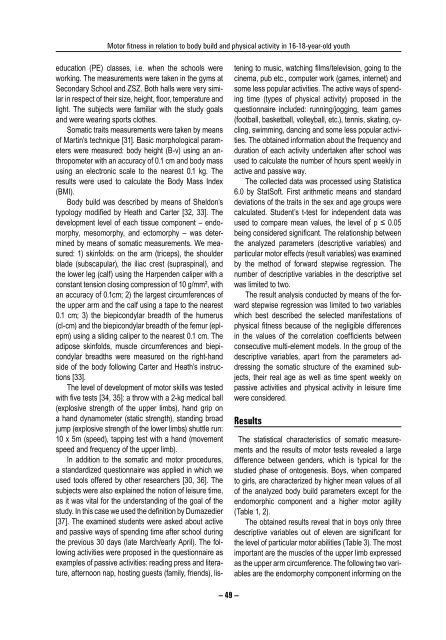Antropomotoryka nr 55.indb - Akademia Wychowania Fizycznego w ...
Antropomotoryka nr 55.indb - Akademia Wychowania Fizycznego w ...
Antropomotoryka nr 55.indb - Akademia Wychowania Fizycznego w ...
Create successful ePaper yourself
Turn your PDF publications into a flip-book with our unique Google optimized e-Paper software.
Motor fitness in relation to body build and physical activity in 16-18-year-old youth<br />
education (PE) classes, i.e. when the schools were<br />
working. The measurements were taken in the gyms at<br />
Secondary School and ZSZ. Both halls were very similar<br />
in respect of their size, height, floor, temperature and<br />
light. The subjects were familiar with the study goals<br />
and were wearing sports clothes.<br />
Somatic traits measurements were taken by means<br />
of Martin’s technique [31]. Basic morphological parameters<br />
were measured: body height (B-v) using an anthropometer<br />
with an accuracy of 0.1 cm and body mass<br />
using an electronic scale to the nearest 0.1 kg. The<br />
results were used to calculate the Body Mass Index<br />
(BMI).<br />
Body build was described by means of Sheldon’s<br />
typology modified by Heath and Carter [32, 33]. The<br />
development level of each tissue component – endomorphy,<br />
mesomorphy, and ectomorphy – was determined<br />
by means of somatic measurements. We measured:<br />
1) skinfolds: on the arm (triceps), the shoulder<br />
blade (subscapular), the iliac crest (supraspinal), and<br />
the lower leg (calf) using the Harpenden caliper with a<br />
constant tension closing compression of 10 g/mm², with<br />
an accuracy of 0.1cm; 2) the largest circumferences of<br />
the upper arm and the calf using a tape to the nearest<br />
0.1 cm; 3) the biepicondylar breadth of the humerus<br />
(cl-cm) and the biepicondylar breadth of the femur (eplepm)<br />
using a sliding caliper to the nearest 0.1 cm. The<br />
adipose skinfolds, muscle circumferences and biepicondylar<br />
breadths were measured on the right-hand<br />
side of the body following Carter and Heath’s instructions<br />
[33].<br />
The level of development of motor skills was tested<br />
with five tests [34, 35]: a throw with a 2-kg medical ball<br />
(explosive strength of the upper limbs), hand grip on<br />
a hand dynamometer (static strength), standing broad<br />
jump (explosive strength of the lower limbs) shuttle run:<br />
10 x 5m (speed), tapping test with a hand (movement<br />
speed and frequency of the upper limb).<br />
In addition to the somatic and motor procedures,<br />
a standardized questionnaire was applied in which we<br />
used tools offered by other researchers [30, 36]. The<br />
subjects were also explained the notion of leisure time,<br />
as it was vital for the understanding of the goal of the<br />
study. In this case we used the definition by Dumazedier<br />
[37]. The examined students were asked about active<br />
and passive ways of spending time after school during<br />
the previous 30 days (late March/early April). The following<br />
activities were proposed in the questionnaire as<br />
examples of passive activities: reading press and literature,<br />
afternoon nap, hosting guests (family, friends), listening<br />
to music, watching films/television, going to the<br />
cinema, pub etc., computer work (games, internet) and<br />
some less popular activities. The active ways of spending<br />
time (types of physical activity) proposed in the<br />
questionnaire included: running/jogging, team games<br />
(football, basketball, volleyball, etc.), tennis, skating, cycling,<br />
swimming, dancing and some less popular activities.<br />
The obtained information about the frequency and<br />
duration of each activity undertaken after school was<br />
used to calculate the number of hours spent weekly in<br />
active and passive way.<br />
The collected data was processed using Statistica<br />
6.0 by StatSoft. First arithmetic means and standard<br />
deviations of the traits in the sex and age groups were<br />
calculated. Student’s t-test for independent data was<br />
used to compare mean values, the level of p ≤ 0.05<br />
being considered significant. The relationship between<br />
the analyzed parameters (descriptive variables) and<br />
particular motor effects (result variables) was examined<br />
by the method of forward stepwise regression. The<br />
number of descriptive variables in the descriptive set<br />
was limited to two.<br />
The result analysis conducted by means of the forward<br />
stepwise regression was limited to two variables<br />
which best described the selected manifestations of<br />
physical fitness because of the negligible differences<br />
in the values of the correlation coefficients between<br />
consecutive multi-element models. In the group of the<br />
descriptive variables, apart from the parameters addressing<br />
the somatic structure of the examined subjects,<br />
their real age as well as time spent weekly on<br />
passive activities and physical activity in leisure time<br />
were considered.<br />
Results<br />
The statistical characteristics of somatic measurements<br />
and the results of motor tests revealed a large<br />
difference between genders, which is typical for the<br />
studied phase of ontogenesis. Boys, when compared<br />
to girls, are characterized by higher mean values of all<br />
of the analyzed body build parameters except for the<br />
endomorphic component and a higher motor agility<br />
(Table 1, 2).<br />
The obtained results reveal that in boys only three<br />
descriptive variables out of eleven are significant for<br />
the level of particular motor abilities (Table 3). The most<br />
important are the muscles of the upper limb expressed<br />
as the upper arm circumference. The following two variables<br />
are the endomorphy component informing on the<br />
– 49 –





![Antropomotoryka nr 57 [2012]. - Akademia Wychowania Fizycznego ...](https://img.yumpu.com/50213388/1/182x260/antropomotoryka-nr-57-2012-akademia-wychowania-fizycznego-.jpg?quality=85)











